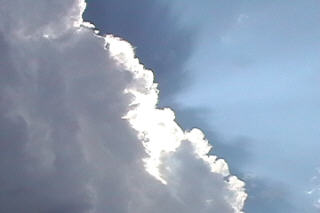 Weather
Terminology Weather
Terminology
Weather Terms To Know In Florida
Hurricane Season
- June 1st through November 30th is officially designated as hurricane
season.
Tropical Depression - A circulation at the surface of the water
with a sustained wind speed of 38 mph or less.
Tropical Storm - Distinct circulation with sustained wind speeds
of 39 to 73 mph.
Tropical Storm Watch - The alert given when a tropical storm
poses a threat to a certain coastal area within 36 hours.
Tropical Storm Warning - A tropical storm is expected to strike
within 24 hours with sustained winds of 39 to 73 mph.
Hurricane - A tropical cyclone that rotates counterclockwise with
sustained winds of 74 mph or greater.
Hurricane Watch - The alert given when a hurricane poses a threat
to a certain coastal area within 36 hours.
Hurricane Warning - A
hurricane is expected to strike within 24 hours with sustained winds of
74 mph or more accompanied by heavy rain and high waves.
Small Craft Advisory - An advisory to alert mariners of expected
or occurring conditions which are considered potentially hazardous to
small weather sensitive boats. This statement is highlighted in the
marine forecast when winds are expected to be greater than 20 knots or
seas 7 feet or higher.
Small Craft Should Exercise Caution - Precautionary statement
issued to alert mariners with small, weather sensitive boats. This
statement is highlighted in the marine forecast when winds are expected
to be 15 to 20 knots or seas to 6 feet.
Special Marine Warning (SMW) - Issued to warn mariners of
short-lived hazardous marine weather situations. Examples of these would
be strong thunderstorms or waterspouts.
Gale Warning - A warning to mariners for expected or occurring
conditions where winds are sustained between 34 and 47 knots for extra
tropical systems.
Land/Sea Breeze - A coastal breeze blowing toward the ocean/land,
caused by temperature differences when the sea surface is warmer (land
breeze) or cooler (sea breeze) than nearby land. Therefore it usually
blows during the night (land breeze) or day (sea breeze).
Marine Weather Statement (MWS)
- Issued to advise the public and marine community of minor coastal
marine problems such as: Heavy surf, beach erosion, rip currents, and
winds less than 35 knots. These statements can also be issued to provide
additional information when a marine warning or advisory is in effect.fect.
Rip Currents
- Also known as rip tide. A strong water-surface current of short
duration flowing seaward from the shore. Usually appears as a band of
agitated water. Swimmers also know this as undertow.
Swells
- Ocean waves that have traveled out of their place of origin. Swells
are characterized by a more regular and longer period and flatter crests
than wind waves.
Tides
- Alternating rise and fall in sea level produced by the interactions
between the earth and primarily the moon and sun. Tides affect bays,
sounds and extend up rivers. Other factors that influence the tides
include coastline shape, water depth, ocean-floor topography and
meteorological effects of different scales. You can check your local
Florida tides by clicking
here.
|

Beaufort Scale of Wind Force
Developed by Admiral Sir Frances Beaufort
in 1805 to determine the effects of wind on water.Force 0:
Calm. Winds less than 1 mph.
Force 1: Light air. Winds 1-3 mph. Ripples on the water's surface.
Force 2: Light breeze, 4-7 mph. Small wavelets developing.
Force 3: Gentle breeze, 8-12 mph. Large wavelets with scattered
whitecaps.
Force 4: Moderate breeze, 13-18 mph. Waves 2-3 feet with whitecaps
becoming numerous.
Force 5: Fresh breeze, 19-24 mph. Waves 4-7 feet. Sea spray begins.
Force 6: Strong breeze, 25-31 mph. Waves 7-14 feet. White caps
everywhere. Spray increasing.
Force 7: Near gale, 32-38 mph. Seas 14-18 feet. Foam begins to blow
in streaks.
Force 8: Gale, 39-46 mph. Blinding foam begins blowing in streaks.
Force 9: Strong gale, 47-54 mph. 20 foot waves.
Force 10: Storm. Wind 55-63 mph. Waves 20-30 feet.
Force 11: Violent storm, 64-73 mph. Waves 30-45 feet.
Force 12: Hurricane, 74-82 mph. Air filled with foam. Waves as high
as 50 feet.
Weather Fronts
Fronts form when air masses of different temperatures collide. When
a cold air mass catches up with warm air, the heavier cold air pushes
under the warm air mass and lifts it, causing stormy weather. In a warm
front, the warm air rides up and over the cold, generally producing less
severe storms than a cold front.
By knowing the normal sequence of weather as a front passes through,
you can predict the weather conditions fairly accurately.
Cold Fronts
Cold fronts move at speeds from 10 to 50 knots. In winter they are 2
or 3 times faster than in summer. A fast-moving cold front may be
preceded by a squall line, a roll of black, threatening clouds with
violent storms. Wind shifts suddenly along the front, and wind
velocities increase dramatically. Behind the squall line are heavy
rains, then clearing, and gusty winds, usually followed by several days
of clear, cool weather.
Warm Fronts
Warm fronts are quite different. The high, thin cirrus clouds that
form when the warm air climbs up and over the retreating cold air mass
can extend as far as 1,000 miles ahead of the front. these clouds
thicken and lower as the front advances, and winds increase steadily. As
the clouds lower, rain or snow begins to fall, continuing until after
the front passes. The winds shift clockwise and decreases. The
temperature begins to rise and visibility becomes poor.
Behind the warm front are thick, low stratus clouds and possibly more
rain. Once the front passes, the skies clear and wind normally blows
from the southwest. Since cold fronts frequently follow a passing warm
front, the duration of good weather may be short.
|


 Weather
Terminology
Weather
Terminology